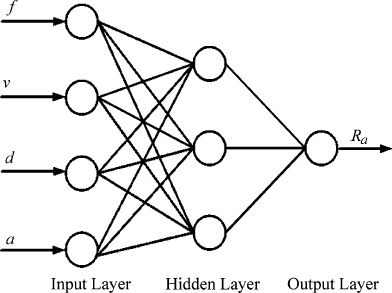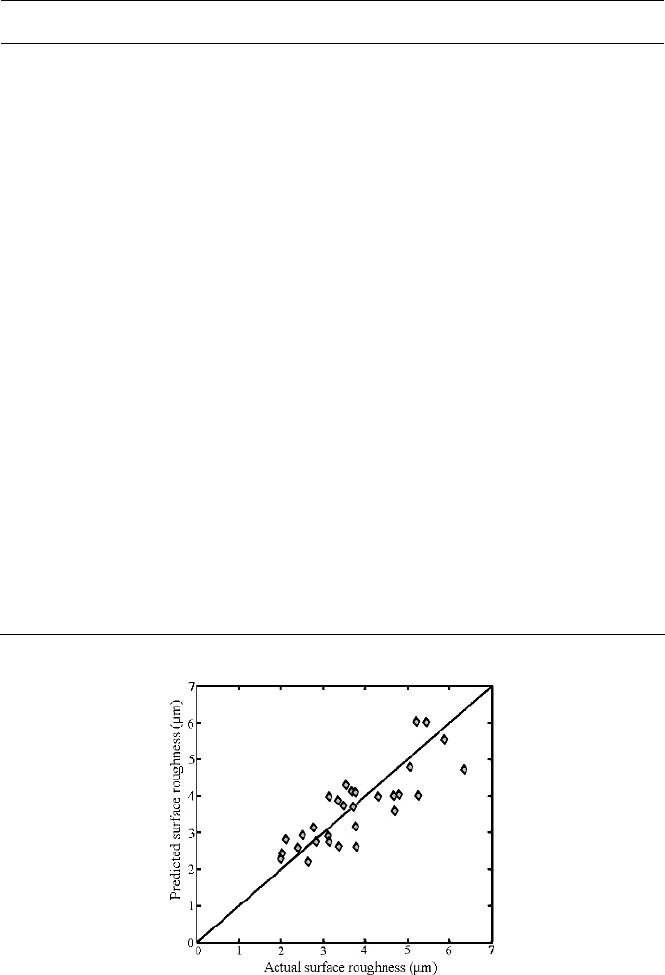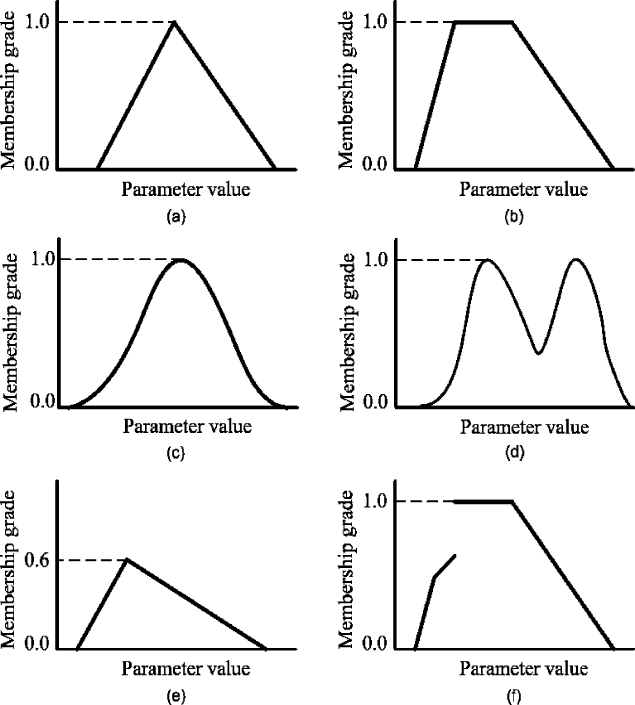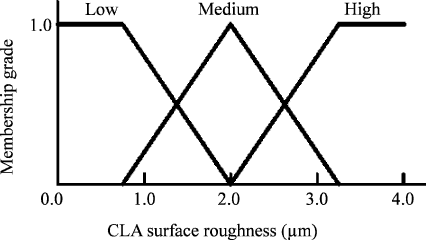Davim J. Paulo (editor). Machining. Fundamentals and Recent Advances
Подождите немного. Документ загружается.


334 S. Deb and U.S. Dixit
Figure 12.4. A typical feedforward neural network
the recurrent networks is the Hopfield network. Hopfield networks are typically
used for classification problems with binary input pattern vectors. Another type of
neural network is the self-organizing neural network that consists of neurons ar-
ranged in the form of a low-dimensional grid. Each input is connected to all the
Figure 12.5. A typical recurrent neural netwok

Intelligent Machining: Computational Methods and Optimization 335
output neurons. This type of network is useful in classifying high-dimensional
data by constructing its own topology.
Neural networks need to be trained so that they produce proper response to a
given input vector. The training process is an iterative process that adjusts the
parameters (weights and biases) of the network until the network is able to pro-
duce the desired output from a set of inputs. The process of training the network
can be broadly classified into supervised and unsupervised learning. A number of
training algorithms based on the supervised learning are available of which the
most common is the backpropagation algorithm. The backpropagation algorithm
supplies the neural network with a sequence of input patterns and desired output
(target) patterns, which together constitute the training exemplars. As an input
pattern is presented to the neural network, the output response is calculated on a
forward pass through the network. In Figure 12.4, the output of each neuron j in
the hidden layer is computed according to the model of Figure 12.3. Given the
input signal x
i
at the input neurons, the output o
j
is given by
=
∑
j
ji i
of(wx), (12.1)
where w
ji
is the weight associated with the jth
neuron of the hidden layer and the
ith
neuron of the input layer. The function f is called the activation function. Some
commonly used activation functions are:
1
1
ct
Log sigmoid: o f ( t ) , where c is a constant,
e
−
==
+
(12.2)
Tan hyperbolic: o f ( t ) tanh(c t/2), where c is a constant,== (12.3)
I
dentity: f (t )=t. (12.4)
The output of each neuron in the output layer is computed in a similar manner.
The final output is compared to the desired output, and error terms are calculated
for each output neuron. A function of the errors of the neurons in the output layer
is then propagated backwards through the network to each layer, and weights of
each of the interconnected neurons are adjusted in such a way that the error be-
tween the desired output and the actual output is reduced. Any optimization
method can be used to find out the weights that minimize the error. Early back-
propagation algorithms were based on the steepest-descent algorithm, according to
which the maximum decrease in the function is in a direction opposite to the direc-
tion of the gradient of the function. Another commonly used backpropagation
algorithm is based on the Levenberg–Marquardt method, which is a combination
of the steepest-descent method and the quasi-Newton method. At initial iterations,
Cauchy’s method is followed and the algorithm gradually moves towards the
quasi-Newton method.
In back propagation algorithms using the steepest-descent or Levenberg–
Marquardt method, the weights may correspond to a local minimum only. This
problem can be solved by adding a momentum term to the training rule, which
forces the weights to keep moving in the same direction in the error surface with-
out becoming trapped in a local minimum. Momentum simply adds a fraction of

336 S. Deb and U.S. Dixit
the previous weight update to the current weights. This increases the size of the
step taken towards minimum. It is therefore necessary to reduce the learning rate
(a factor that determines how much change in the weights is carried out at each
step) when using a lot of momentum. If a high learning rate is used, the algorithm
may oscillate around the minimum and may become unstable. Too small a learn-
ing rate will take a long time to converge. The optimum value of learning rate is
often found by trial and error.
A radial basis function neural network has weights only between the hidden
layer and the output layer. There are no weights between the input layer and the
hidden layer. With each node in the hidden layer, a centre x
k
is associated, which
is a vector with the same dimension as the input vector. Usually the centres are
chosen in a random manner from the input dataset. The output o then becomes
()
1=
=
∑
m
kk k
k
owg|| ||,s,
k
x-x
(12.5)
where
x is the input vector, || - ||
k
xx is the Euclidian norm,
k
s
is the spread pa-
rameter,
w
k
are weights,
()
kk
g
|| ||,s
k
x-c is the radial basis function (RBF) and m
is the number of centres, which is the same as the number of neurons in the hidden
layer. Some of the most common RBFs are:
()
12
2
2
=+
/
kk
Multiquadrics: g ( x ) s
k
x-x ; (12.6)
()
12
2
2
−
=+
/
kk
Inverse multiquadrics: g ( x ) s
k
x-x ; (12.7)
2
2
k
s
k
Gaussians: g ( ) e
−
=
k
x-x
x ; (12.8)
2
k
Thin plate splines: g ( x ) log=
kk
x-x x-x . (12.9)
Once the type of RBF function is decided and the centres are fixed, the output
o
given by Equation (12.5) becomes a linear combination of the weights. With the
input and output dataset provided, the weights can be calculated using a multiple
linear regression procedure so that the sum squared error between the predicted
and the target output is minimized.
The process of training the neural network using supervised learning is appli-
cable to problems where representative exemplars of both input pattern and output
(target) patterns are known. In many problems where the target patterns are un-
known, unsupervised learning is used. In the unsupervised learning process, the
network is provided with a dataset containing input patterns but not with desired
output patterns. The unsupervised learning algorithm then performs clustering of
the data into similar groups based on the measured attributes or features of the
given input patterns serving as inputs to the algorithms. After the training of the
neural network by a suitable method, the trained network needs to be tested with
unseen data (not included in the training dataset).

Intelligent Machining: Computational Methods and Optimization 337
In the area of machining, neural networks have been used for the prediction of
cutting forces [1,
2], surface roughness [3–6], dimensional deviation [3,
4], tool
wear [6,
7] and tool life [8,
9]. Risbood et al. [4] fitted a neural network for the
prediction of surface roughness and dimensional deviation in a turning process.
For the wet machining of steel with a high-speed steel (HSS) tool with 8% cobalt,
they used only 18 training data and 8 testing data for the prediction of surface
roughness. The weight adjustment is carried out by training data and the trained
neural network is tested by some data to ensure that there is no overfitting of the
network. The multilayer perceptron neural network architecture used by the au-
thors is shown in Figure 12.6. The input neurons correspond to feed
f, cutting
speed
v, depth of cut d and acceleration of radial vibrations a of the turning tool,
and the output neuron corresponds to the surface roughness
R
a
. The accelerations
of the radial vibration were measured using an accelerometer. The training and
testing data are shown in Table 12.1. While designing the network topology and
training, it was ensured that the testing error was below 20% for each data. Later
the fitted neural network was validated with 32 validation data. These data were
not used in the training and testing. The results are shown in Table 12.2, where
R
a
is the experimentally obtained surface roughness and
a
ˆ
R
is the neural network
predicted surface roughness. It is seen that, in 24 out of 32 cases, the error in pre-
diction of surface roughness is less than 20%. Only in four cases is the error more
than 25%, with a maximum error of 31.9%. Figure 12.7 shows the performance of
the neural network pictorially. When a graph is plotted between actual and pre-
dicted values of surface roughness, most of the points are found to fall in the
neighbourhood of the line passing through the origin and equally inclined from the
two axes. Sonar
et al. [10] fitted a RBF neural network to the data and obtained
almost same prediction accuracy in a shorter computational time.
Figure 12.6. The neural network architecture for the prediction of surface roughness From
Risbood et al. [4] copyright 2003, Elsevier

338 S. Deb and U.S. Dixit
Table 12.1. Training and testing data for a wet turning operation, from Risbood et al. [4]
copyright 2003, Elsevier
S.
No.
v
(m/min)
d
(mm)
f
(mm/rev)
a
(m/s
2
)
R
a
(µm)
1 107.82 0.30 0.04 0.55 1.74
2 106.47 0.30 0.08 0.65 2.26
3 105.12 0.30 0.16 0.97 3.23
4 104.80 0.60 0.04 2.92 2.74
5 103.55 0.60 0.08 3.66 3.59
6 106.02 0.60 0.16 2.66 2.91
7 47.17 0.30 0.04 0.90 2.31
8 46.55 0.30 0.08 0.73 3.21
9 45.95 0.30 0.16 2.41 4.64
10 48.75 0.60 0.04 0.65 3.18
11 48.14 0.60 0.08 0.58 4.52
12 47.52 0.60 0.16 1.73 5.43
13 27.71 0.30 0.04 0.95 2.06
14 27.35 0.30 0.08 0.83 2.90
15 26.99 0.30 0.16 0.88 5.20
16 27.71 0.60 0.04 0.59 2.87
17 27.35 0.60 0.08 0.72 4.00
18 26.99 0.60 0.16 1.42 6.20
1
a
74.13 0.40 0.10 2.48 4.80
2
a
42.98 0.40 0.10 0.67 4.24
3
a
36.87 0.50 0.12 1.07 4.55
4
a
35.96 0.30 0.12 0.95 5.21
5
a
78.10 0.60 0.12 2.10 4.57
6
a
76.43 0.60 0.05 1.23 2.91
7
a
73.95 0.30 0.05 0.76 2.52
8
a
72.92 0.60 0.04 0.79 2.81
a
test datasets
Figure 12.7. Predicted versus actual surface roughness in turning by HSS tool in the
presence of coolant. From Risbood et al. [4] copyright 2003, Elsevier

Intelligent Machining: Computational Methods and Optimization 339
Table 12.2. Results of experiments carried out to test the performance of fitted neural
network model for the wet turning operation. from Risbood et al. [4] copyright 2003, Elsevier
S. no.
F
(mm/rev)
v
(m/min)
d
(mm)
a
(m/s
2
)
a
R
(µm)
ˆ
a
R
(µm)
%
error
1 0.08 34.71 0.60 0.63 3.67 4.15 –13.10
2 0.04 23.45 0.30 0.42 1.99 2.28 –14.57
3 0.04 64.56 0.40 0.66 2.13 2.81 –31.90
4 0.12 32.87 0.30 0.48 4.29 3.98 7.23
5 0.04 54.28 0.60 0.55 2.78 3.12 –12.23
6 0.16 29.39 0.60 1.12 5.22 6.02 –15.32
7 0.12 20.88 0.40 0.67 4.79 4.04 15.65
8 0.08 54.91 0.40 2.80 3.53 4.33 –22.66
9 0.06 38.50 0.30 0.47 3.37 2.64 21.66
10 0.08 34.71 0.60 0.57 3.73 4.13 –10.72
11 0.04 23.45 0.30 0.52 1.99 2.26 –13.56
12 0.04 64.56 0.40 0.54 2.84 2.75 3.16
13 0.12 32.87 0.30 0.55 5.26 4.03 23.38
14 0.04 54.28 0.60 0.71 3.76 3.17 15.61
15 0.16 29.39 0.60 0.98 5.44 6.02 –10.66
16 0.12 20.88 0.40 0.73 3.76 4.09 –8.77
17 0.08 54.91 0.40 0.73 3.48 3.76 –8.05
18 0.06 38.50 0.30 0.56 3.77 2.63 30.23
19 0.04 48.70 0.40 0.54 2.39 2.56 –7.11
20 0.08 61.88 0.50 0.98 4.68 3.99 14.74
21 0.08 60.56 0.50 0.77 3.14 4.00 –27.38
22 0.16 100.85 0.50 1.49 3.11 2.90 6.75
23 0.04 26.48 0.40 0.37 2.03 2.41 –18.72
24 0.06 49.25 0.30 0.86 3.13 2.78 11.18
25 0.04 106.34 0.30 0.94 2.65 2.20 16.98
26 0.06 45.95 0.60 1.16 3.70 3.70 0.00
27 0.06 101.80 0.60 2.70 2.51 2.93 –16.73
28 0.16 45.99 0.30 1.15 5.87 5.54 5.62
29 0.16 104.20 0.30 2.23 3.36 3.89 –15.77
30 0.16 45.95 0.60 2.28 5.06 4.80 5.14
31 0.16 46.97 0.60 2.43 6.35 4.74 25.35
32 0.16 103.10 0.60 3.32 4.72 3.59 23.94
12.3 Fuzzy Set Theory
In the conventional crisp set theory, an element is either a member of the set or a
non-member of the set. With each member, we can associate a number 1 or 0,
340 S. Deb and U.S. Dixit
depending on whether it is a member or non-member of the particular set. We may
call this number the membership grade of the element in the set. In crisp set the-
ory, the membership grades of the elements contained in the set are 1 and the
membership grades of the elements not contained in the set are 0. In fuzzy set
theory, the value of the membership grade of an element of the universe may have
any value in the closed interval [0,
1]. A membership grade 1 indicates full mem-
bership and 0 indicates full non-membership in the set. Any other membership
grade between 0 and 1 indicates partial membership of the element in the set.
Let us consider an example to understand the concept of crisp and fuzzy set.
Assume that there are five machined shafts designated by
a, b, c, d and e. The
CLA surface roughness values of the machined shafts are 0.6, 0.8, 1.2, 3.0 and 4.1
μm, respectively. If we construct a set A as the set of shafts having surface rough-
ness less than 1.5
μm, then clearly the shafts a, b and c are the members of the set
and set
A may be represented as
=
A
{a,b,c}. (12.10)
Now, let us construct another set
B of shafts having low surface roughness.
There is a degree of subjectivity in deciding the definition of low surface rough-
ness in a particular context. One possible fuzzy set
B may be
=B{1/a, 0.8/b, 0.5/c, 0/d, 0/e}, (12.11)
In the above set, the shafts have membership grades of 1, 0.8, 0.5, 0 and 0 re-
spectively, indicated before an oblique slash with each shaft. Here, shaft
a is a full
member of the set B, shafts b and c are partial members, and shafts d and e are
non-members. Someone else may wish to form the set
B as
=B{1/a, 0.9/b, 0.6/c, 0/d, 0/e}, (12.12)
Here, the membership grades of
b and c have changed; nevertheless the mem-
bership grade of b is more than that of c. Thus, although the membership grades
are subjective, they are not arbitrary. However, some skill is needed in the forma-
tion of a fuzzy set that properly represents the linguistic name assigned to the
fuzzy set.
Fuzzy set theory may be called a generalization of conventional crisp set the-
ory. Various set-theoretic operations commonly used in crisp set theory have been
defined for fuzzy set theory as well. These operations reduce to their conventional
forms for crisp sets. For example, the intersection of two fuzzy sets
A and B, i.e.,
∩
A
B is defined as a set in which each element has a membership grade equal to
the minimum of its membership grades in A and B. Similarly, the union of two
fuzzy sets
A and B, i.e., ∪
A
B is defined as the set in which each element has a
membership grade equal to the maximum of its membership grades in A and B.
The application of fuzzy sets extends to logic. In the classical binary logic, a
statement is either true or false. Quantitatively, we can say that the truth value of a
statement is either 1 or 0. In fuzzy logic, it is possible for a statement to have any
truth value in the closed interval [0,
1]. For example, the statement “The CLA
surface roughness value of 1.2
μm is a low surface roughness.” may be assigned a
truth value of 0.7 by some expert.

Intelligent Machining: Computational Methods and Optimization 341
Another offshoot of fuzzy set theory is fuzzy arithmetic. Fuzzy arithmetic deals
with operations on fuzzy numbers. The fuzzy numbers are generalization of inter-
val numbers. An interval number is specified by an upper and a lower bound. For
example, (3, 5) is an interval number with a lower bound of 3 and upper bound of
5. The interval numbers are used when the value of a variable is expected to lie in
a range. A fuzzy number consists of the different interval numbers at different
membership grades. A requirement of the fuzzy number is that the membership
grade function of fuzzy number should be convex. Figure 12.8 shows examples of
valid and invalid fuzzy numbers.
The fuzzy arithmetic operations are defined over each
α
-cut. An
α
-cut of
a membership grade function
μ
(x) is the set of all x such that
μ
(x) is greater or
Figure 12.8. The valid and invalid fuzzy numbers: (a) a valid triangular fuzzy number, (b)
a valid trapezoidal fuzzy number, (c) a valid bell-shaped fuzzy number, (d) a non-convex
invalid fuzzy number (e), a non-normal invalid fuzzy number and (f) a discontinuous
invalid fuzzy number
342 S. Deb and U.S. Dixit
equal to
α
. Thus, at a particular
α
-cut, an interval number is obtained correspond-
ing to the interval number at the membership grade of
α
. If two fuzzy numbers are
represented by
12
αα
(a ,a ) and
12
αα
(b ,b ) at an
α
-cut, then four basic arithmetic
operations are defined as follows:
()()( )
12 12 1 12 2
αα αα α αα α
+=++
A
ddition: a ,a b ,b a b ,a b , (12.13a)
()()( )
12 12 1 22 1
αα αα α αα α
−=−−Subtraction: a ,a b ,b a b ,a b , (12.13b)
()()( )
12 12 1 12 2
αα αα α αα α
×=××
M
ultiplication: a ,a b ,b a b ,a b , (12.13c)
()()( )
12 12 1 22 1
αα αα α αα α
÷=÷÷Division: a ,a b ,b a b ,a b . (12.13d)
Other arithmetic operations can be derived from these four basic operations.
The fuzzy arithmetic operations can be used to obtain the fuzzy value of the ex-
pression. Care must be taken when a variable occurs more than once in an expres-
sion. In this case, the blind application of fuzzy arithmetic will provide wider than
realistic interval of the value of expression at an
α
-cut. One way to avoid this
problem is to carry out one computation by taking the lower bound, and the other
computation by taking the upper bound of the variable at each
α
-cut.
In many situations, a fuzzy parameter is estimated by a computer code rather
than by a closed-form expression. In this case, at each
α
-cut, the upper bound of
the parameter may be obtained by running the code for those combinations of
lower and upper bounds of the independent variables that provide the lower and
upper bounds of the parameter. In machining process, a number of imprecise vari-
ables are involved that can be represented by fuzzy numbers, and computation can
be carried out to get an estimate of the dependent variables in the form of fuzzy
numbers. The material parameters and the friction, for example, can be treated as
fuzzy numbers in finite element code to predict the cutting forces in the form of
the fuzzy numbers. This will provide more insight to a higher level decision-maker
than the prediction in the form of the crisp numbers.
The fuzzy set theory can also be used to make prediction from the data. As an
example, suppose that, in a finish turning process, the surface roughness of the
turned job is to be predicted for a particular feed and cutting speed. The estimation
of surface roughness consists of four steps. The first step is fuzzification, in which
the crisp values of feed and cutting speed are fuzzified,
i.e., they are assigned to
linguistic fuzzy sets. A variable may be associated with more than one fuzzy set
with different membership grades for different sets. For example, the given feed
value may be called “high feed” with a membership grade
1
μ
and “low feed” with
a membership grade
2
μ
. Similarly, the cutting speed may be called “low cutting
speed” with a membership grade
3
μ
and “high cutting speed” with a membership
grade
4
μ
.
Once the independent variables are fuzzified, the next step is carried out. In this
step, called the rule evaluation step, the strength of the various rules is evaluated.

Intelligent Machining: Computational Methods and Optimization 343
Various rules are kept in a rule bank, which may be prepared by experts based on
their experience or may be generated from data following systematic procedures
[11]. For the present example, the four rules could be:
Rule 1: If the feed is low and the cutting speed is low, then the surface rough-
ness is medium.
Rule 2: If the feed is low and the cutting speed is high, then the surface rough-
ness is low.
Rule 3: If the feed is high and the cutting speed is low, then the surface rough-
ness is high.
Rule 4: If the feed is high and the cutting speed is high, then the surface rough-
ness is medium.
In each rule, the ‘if’ part is called the antecedent and the ‘then’ part is called the
consequent. The strength of a rule is equal to the truth value of the antecedent. If
the antecedent consists of the statements separated by ‘and’, which is equivalent to
intersection operation, the truth value of the antecedent is equal to the minimum of
the truth values of each of the statements. For example, consider the first rule. The
membership of the given feed value in the fuzzy set ‘low feed’ is
2
μ
, as described
before. Hence, the truth value of the statement ‘the feed is low’ is
2
μ
. Similarly,
the membership of the given cutting speed in the fuzzy set ‘low cutting speed’ is
3
μ
. As both statements in the antecedent are separated by ‘and’, the truth value of
rule 1 is min(
2
μ
,
3
μ
). This is the strength of the rule. If the antecedent consists of
the statements separated by ‘or’, which is equivalent to the union operation, the
truth value of the antecedent is equal to the maximum of the truth values of each
of the statements. For a given feed and cutting speed, a number of rules are appli-
cable with different strengths. Now, we pay attention to the consequent part of the
rules. Let us assume that the strengths of the four rules in the above example are
0.06, 0.14, 0.24 and 0.56. Membership functions for the fuzzy sets “low surface
roughness”, “medium surface roughness” and “high surface roughness” are shown
in Figure 12.9. These fuzzy sets are clipped at the membership grades correspond-
ing to the rule strengths, as shown in Figure 12.10. The clipping is done by slicing
off the portion of the membership function having membership grade more than
the strength of the rule.
Figure 12.9. Fuzzification of CLA surface roughness
